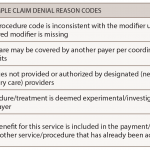
arka38 / shutterstock.com
Maintaining a health revenue cycle in a medical practice comes with myriad moving parts. Numerous external forces, such as economic conditions, government programs (e.g., the Zone Program Integrity Contractor [ZPIC], the Health Information Technology for Economic Clinical Health [HITECH]) and legislation passed under healthcare reform, mandate healthcare organizations to begin managing internal processes, such as claims submission, to ensure office compliance and accurate reimbursement.
To optimize reimbursement and maximize revenue, practices must submit clean claims. A clean claim is defined by Medicare as a claim “that has no defect, impropriety, lack of any required substantiating documentation—including the substantiating documentation needed to meet the requirements for encounter data—or particular circumstance requiring special treatment that prevents timely payment.”1
This means a clean claim is one that was accurately processed and reimbursed the first time it was submitted to the payer. Unfortunately, submitting clean claims and reducing a practice’s denial rates can be challenging due to complex and changing payer policies and procedures. Various best practices can be put in place to ensure the submission of clean claims and improve the revenue cycle flow.
Setting up continuous, proactive methods can minimize the submission of incomplete or inaccurate claims. First, all staff, including physicians and healthcare professionals, need to understand all payer rules, including those set by Medicare and other third-party payers. Second, practices should have a process in place for analyzing and reviewing denials and underpayments in an effort to identify the root cause of the denial (e.g., internal or external).
A substantial amount of time and resource utilization are invested in the resubmission of claims. Keep in mind that each time a carrier denies a claim, it must be revisited: The denial has to be identified, appropriate action has to be taken, and the claim cycle must begin again.
Practice administrators can develop reports to track and monitor denials to detect areas of vulnerability in the practice to maximize the number of claims paid on the first submission. Below are three areas practices should evaluate for improvement to ensure the ratio favors clean claims submission:
Ensure Correct & Updated Patient Information on Claims
Best practices start at the front desk, where accuracy in data entry of the patient’s demographics and insurance information begins. Insurance coverage verification and keying in which insurance is primary and which is secondary is very important for claims submission. Also, staff must confirm patient responsibility at the time of the visit, accounting for the deductible, co-insurance or copay.



